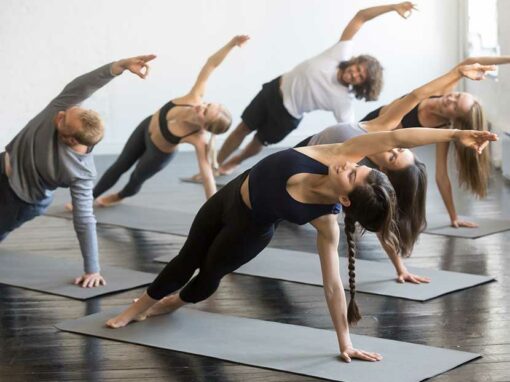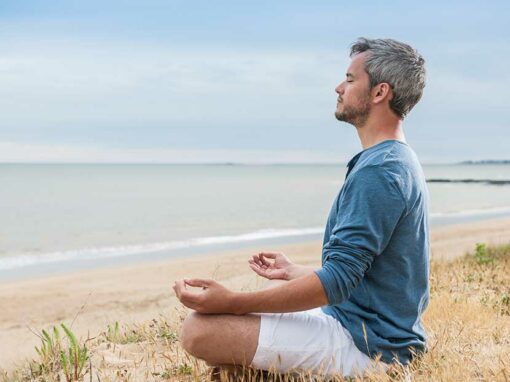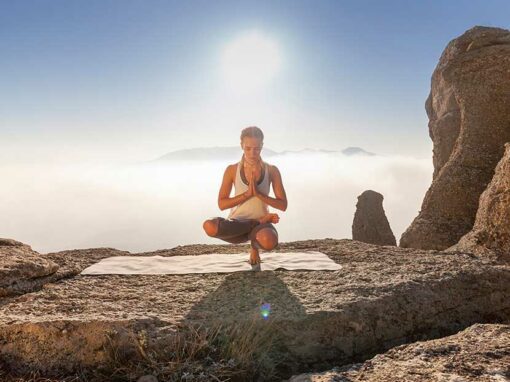– Guest blog post by Marianna –
History Of Yin Yoga
When I step into something new for me, I like to know more about the history of it and how the past has influenced it.
That’s why I would like to introduce Yin Yoga by giving you an overview of how it has developed so far.
Where Does “Yin Yoga” Come From?
Sarah Powers coined the term ‘Yin Yoga’ in 2000 after she crossed Paul Grilley’s path. Before that, Paul had been referring to his practice as Taoist Yoga.
In reality, Yin has been part of the asana practice since the beginning. In the earliest books as the Vedas, and the Yoga Sutra, asana was still a very minor aspect of the practice.
All that is said about asana in the Yoga Sutra is that it should be sthira and sukham: steady and comfortable. These are very much yin qualities, compared to the style of asana we see performed today in yoga classes.
As time went on and England began to colonize Indian culture and change the school system, asanas were beginning to become blended with forms from the gymnasiums, and yoga practice became more and more yang-like.


This started leading to an imbalance, and yoga could not continue to be more and more yang without someone finding a way to bring it back into balance.
Paul Grilley combined the knowledge he had been given on anatomy, Daoist Yoga, and the meridian theory into the core of his Yin Yoga teachings.
What Does Yin Yoga Do To Our Bodies?
Yin Yoga has the same goals and objectives as any other yoga school; however, it directs the stimulation normally created in the asana portion of the practice deeper than the superficial or muscular tissues (which we call the yang tissues).
Yin Yoga targets the connective tissues, such as the ligaments, bones, and even the body joints, that usually are not exercised very much in a more active style of asana practice.
It is a perfect complement to the dynamic and muscular (yang) styles of yoga that emphasize internal heat and the lengthening and contracting of our muscles. Yin Yoga generally targets the connective tissues of the hips, pelvis, and lower spine.
The Benefits
The benefits of yoga are pretty much well known and can be found in every aspect of human health: physically, emotionally, and mentally as well as, spiritually.
In this article, I will focus more on the benefits of the yin approach targeting the annamaya kosha – the physical body.
We physically do three things to our bodies in yoga asana practice: compression, tension, and shear. As said before, Yin Yoga focuses on the connective tissues and specifically strengthening or maintaining your joints’ health.
4 reasons to add Yin Yoga to your practice:
Prevent Contracture
In case of loss of mobility of a joint due to illness, nerve damage, muscle atrophy, the treatment is mobilization.
Through Yin Yoga techniques, we gently but persistently move the body through its tolerable range of motions and hold the body there. Eventually, we regain or even expand the original range of motion of the joint and combat contracture.


Prevent Degeneration
The body continually creates bone and absorbs bone. If this gets out of balance, we can start to gain bone mass, causing the strengthening of the bone, or we can start to lose bone density, and the bone degenerates.
Physical activity can cause bones to grow stronger, and actually, change size and shape. It is well known that active people are less likely to develop osteoporosis.
The bones need to be stressed to remain healthy, but too much stress can be dangerous. Yin Yoga provides compressive stress on the bones, especially the lumbar spine.
In Yin Yoga the stresses are held longer, allowing the bones more time to be stressed. Very few active yoga postures will stress the lumbar bones as Yin Yoga does.
Reduce Fixation
Fixation is a temporary sticking together of two surfaces. Breaking fixation feels good because the release is enjoyable, and it prevents the fusion of a joint.
The joint becomes useless when the bones are fused. Fusion can happen to anyone, and it is age-related.
Fusion begins with fixation; fixation is cured by mobility, and mobility of the joints is one of the big benefits of Yin Yoga.
Provide Hydration
As we age, we dry up, we get stiffer because the body produces fewer fibroblasts, and those that the body does, produce less hyaluronic acid, the biggest contributor to hydration.
The best approach is to stimulate the growth of more fibroblasts and increase their production of water-attracting molecules.


Fibroblasts are stimulated through stress. Squeezing, compressing, and stretching the connective tissues where fibroblasts reside enables them to produce more HA.
We have to make sure we are providing the stresses the tissues need and in an appropriate way. That is what yoga does. Yin Yoga precisely does this for the joints and the deeper connective tissues, but all yoga will do this for the more superficial and myofascial tissues as well.
Why Use Props In Yin Yoga
The intention of Yinsters is not to look any particular way; it is not to get into a pose: the intention is to feel a particular way; to use the pose to get into the body. If props can help us with this, let’s use props!
There are several benefits and reasons for using props:
- To increase stress in desired areas
- To decrease stress in undesired areas
- To create length and space
- To make certain positions available/accessible
- To provide support: when the bones feel supported, the muscles can relax
- To increase comfort: which means longer stays in the postures
What Can Be Used As Props For Yin Yoga?
Here you go a list to get an idea of what we can use as props:
Remember though: if a prop doesn’t help us stay longer or doesn’t help us feel the pose where we want to feel it, there is no point in using it. Also, pain can arise the next day, so if you feel that you have gone too deep in your practice, or lingered too long, back off.
Source:
Marianna has been practicing Yoga for more than eight years, and in 2020
she completed the 200h Yoga Teacher Training in Vinyasa at YogaMoves in Utrecht.
She is passionate about sharing Yoga with others, living more sustainably,
and traveling. Here is her INSTAGRAM page.





